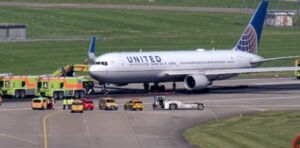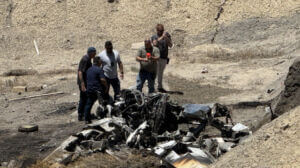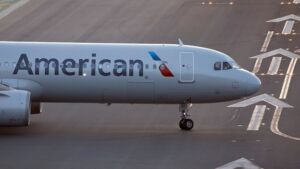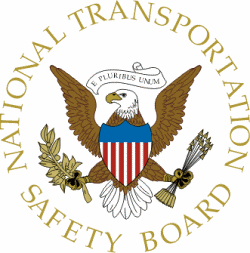Here are your stories for today...
Be safe out there!
Tom
Plane aborts takeoff in Zurich at 264 km/h – passengers evacuated
A Boeing 767 had to abort takeoff at Zurich Airport shortly after 10 a.m. on Tuesday morning, immediately before takeoff.
By Lorenzo Petro, Martin Liebrich
A United Airlines Boeing 767 blocked a runway at Zurich Airport on Tuesday morning. The plane, carrying 142 people, was scheduled to take off for Chicago shortly after 10 a.m. However, before takeoff could begin, the plane aborted takeoff. The reason for this is still unclear.
runway at Zurich Airport on Tuesday morning. The plane, carrying 142 people, was scheduled to take off for Chicago shortly after 10 a.m. However, before takeoff could begin, the plane aborted takeoff. The reason for this is still unclear.
According to data from the live tracking service Flightradar24.com , the aircraft reached a speed of 264 km/h on the runway before braking again. Aircraft of this type can take off at around 250 km/h.
Brakes must be cooled immediately
In such cases, the airport fire department is dispatched to cool the brakes. As a result, the aircraft blocked runway 16/34 for an extended period, with several tires bursting. Flat tires are not uncommon when aborting takeoff after reaching the speed reached. After all, the brakes have to absorb all the energy. This causes them to overheat, which can cause the tires to burst. The aircraft was supposed to take off toward Schwamendingen. Runway 32, toward Höri, was subsequently used for takeoffs.
According to Zurich Airport, the passengers were evacuated and taken back to the terminal. The exact nature of the problem remains unclear. The pilot of United Flight 12 radioed that they could leave the runway, but wanted to go to a location where they could stop and go through the checklist. This didn't happen, however, because the tower instructed them to stay where they were – rescue teams were on their way. "Okay, I'm holding position," the pilot confirmed.
She later confirmed that everything was operating normally. The pilot was instructed to shut down both engines. The pilot reacted with some surprise and asked if she really should shut down the engines and not leave the runway first. The tower confirmed the procedure. Shortly afterward, the aircraft was evacuated.
https://www.tagesanzeiger.ch/boeing-bricht-start-in-zuerich-bei-264-km-h-ab-passagiere-evakuiert-622297961540
2 dead in small plane crash in western Colorado city of Montrose, officials say
By Austen Erblat
Two people died in a small plane crash in the western Colorado city of Montrose on Monday, the Montrose County Sheriff's Office said.
western Colorado city of Montrose on Monday, the Montrose County Sheriff's Office said.
The crash was reported around 11:30 a.m. near the Montrose Regional Airport, sheriff's office officials said.
Few other details, including impacts to local traffic, were immediately available, but data from the flight tracking service FlightAware shows the plane crashed about 30 miles northwest of the airport.
The plane's registration with the Federal Aviation Administration shows that it's a 2008 Blue Brent Bear, a single-engine, experimental, amateur-built plane registered out of Fort Myers, Florida.
First responders were en route to the crash site and asked people to avoid the area north of the airport on County Road.
https://www.cbsnews.com/colorado/news/plane-crashes-montrose-colorado/
American Airlines plane hit with 'unexpected turbulence,' 5 hospitalized
FAA investigating after 3 crew members, 2 passengers to hospitalized
Five people aboard an American Airlines flight were hospitalized Sunday after the airline said the aircraft experienced "unexpected turbulence."
the airline said the aircraft experienced "unexpected turbulence."
American Airlines Flight 1286 was traveling from Miami to Raleigh-Durham in North Carolina when the plane hit turbulence, an American Airlines spokesperson told Fox News Digital in a statement.
The plane, an Airbus A321, landed safely at Raleigh-Durham International Airport at around 10:50 p.m. "after the crew reported possible injuries to cabin crew and passengers due to turbulence," the Federal Aviation Administration (FAA) said in a statement.
An airport spokesperson told Fox News Digital in a statement that RDU Fire Rescue, along with rescue personnel from Wake and Durham Counties, met the flight when it landed around 11:30 p.m. and rushed five individuals to a nearby hospital.
Three flight attendants and two passengers were taken to the hospital, according to the airline, and later released. No further details about the extent of any injuries were immediately provided. The airline added that the seat belt sign was on when the flight encountered turbulence.
Passengers who said they were aboard the flight described the ordeal to WRAL News.
"It was like being on the top of a roller coaster and going down," said one passenger, who wanted to remain anonymous. "It sounded like we hit something and then we just dropped in the air."
Another passenger told the outlet that the sudden shift in altitude sent people, laptops, cell phones and items from the drinks cart "flying in every direction" in the cabin.
A passenger described seeing two flight attendants get injured, including one they said suffered a broken arm and another who was burned from hot water on the drinks cart. The passenger said a man was also knocked unconscious.
"I would say it was absolutely horrific," one passenger told the outlet. "People thought that they were going to lose their lives."
The FAA said it will investigate the incident.
https://www.foxnews.com/us/american-airlines-plane-hit-unexpected-turbulence-5-hospitalized
NTSB Prelim: RANS S20
About 800 Ft Above Ground Level, The Airplane Had A Total Loss Of Engine Power
Location: Fairfield, UT Accident Number: WPR25LA163
Date & Time: May 27, 2025, 13:30 Local Registration: N327KM
Aircraft: RANS S20 Injuries: 1 None
Flight Conducted Under: Part 91: General aviation - Personal
On May 27, 2025, about 1330 mountain daylight time, an experimental amateur-built RANS S20 Raven, N327KM, was substantially damaged when it was involved in an accident near Fairfield, Utah. The pilot was not injured. The airplane was operated as a Title 14 Code of Federal Regulations Part 91 personal flight.
The pilot reported that shortly after departing the runway at the West Desert Airpark (UT9), Fairfield, Utah, about 800 ft above ground level, the airplane had a total loss of engine power followed by an error message on the multi function display. The pilot attempted to restart the engine but was unsuccessful, and initiated a forced landing on a field.
The airplane landed hard on a vegetated field and sustained substantial damage to the fuselage.
The airplane was recovered to a secure location for further examination.
FMI: www.ntsb.gov

Today in History
50 Years ago today: On 24 June 1975 Eastern Air Lines flight EA66, a Boeing 727, crashed following a windshear encounter while on approach to New York-JFK Airport, NY, USA, killing 113 occupants; 11 survived the accident.
| Date: | Tuesday 24 June 1975 |
| Time: | 16:05 |
| Type: | Boeing 727-225 |
| Owner/operator: | Eastern Air Lines |
| Registration: | N8845E |
| MSN: | 20443/837 |
| Year of manufacture: | 1970 |
| Total airframe hrs: | 12206 hours |
| Engine model: | P&W JT8D-7A |
| Fatalities: | Fatalities: 113 / Occupants: 124 |
| Other fatalities: | 0 |
| Aircraft damage: | Destroyed, written off |
| Category: | Accident |
| Location: | New York-John F. Kennedy International Airport, NY (JFK) - United States of America |
| Phase: | Approach |
| Nature: | Passenger - Scheduled |
| Departure airport: | New Orleans International Airport, LA (MSY/KMSY) |
| Destination airport: | New York-John F. Kennedy International Airport, NY (JFK/KJFK) |
| Investigating agency: | NTSB |
| Confidence Rating: | Accident investigation report completed and information captured |
Narrative:
Eastern Air Lines flight EA66, a Boeing 727, crashed following a windshear encounter while on approach to New York-JFK Airport, NY, USA, killing 113 occupants; 11 survived the accident.
Eastern Air Lines Flight 66, a Boeing 727-225 operated as a scheduled passenger flight from New Orleans to New York-JFK. The flight departed New Orleans about 13:19. It proceeded on an IFR flight plan. Eastern 66 arrived in the New York City terminal area without reported difficulty, and, beginning at 15:35:11, Kennedy approach control provided radar vectors to sequence the flight with other traffic and to position it for an ILS approach to runway 22L at the Kennedy airport. The automatic terminal information service (ATIS) reported: "Kennedy weather, VFR, sky partially obscured, estimated ceiling 4,000 broken, 5 miles with haze... wind 210° at 10, altimeter 30.15, Expect vectors to an ILS runway 22L, landing runway 22L, departures are off 22R... "
At 15:52:43, the controller transmitted, "All aircraft this frequency, we just went IFR with 2 miles very light rain showers and haze. The runway visual range is---not available, and Eastern 66 descend and maintain four thousand, Kennedy radar one three two four." Eastern 66 acknowledged the transmission. At 15:53:22, the flight contacted the Kennedy final vector controller, who continued to provide radar vectors around thunderstorms in the area, to sequence the flight with other traffic, and to position the flight on the localizer course. The flightcrew then discussed the problems associated with carrying minimum fuel loads when confronted with delays in terminal areas. One of the crewmembers stated that he was going to check the weather at the alternate airport, which was LaGuardia Airport (LGA). Less than a minute later, one of the crewmembers remarked, "... one more hour and we'd come down whether we wanted to or not." At 15:59:19, the final vector controller transmitted a message to all aircraft on his frequency that "a severe wind shift" had been reported on the final approach and that he would report more information shortly.
Eastern Air Lines Flight 902, a Lockheed L-1011 TriStar, had abandoned its approach to runway 22L earlier. At 15:59:40, Eastern 902 re-established radio communications with the Kennedy final vector controller, and the flightcrew reported, "... we had... a pretty good shear pulling us to the right and... down and visibility was nil, nil out over the marker... correction... at 200 feet it was... nothing." The final vector controller responded, "Okay, the shear you say pulled you right and down?" Eastern 902 replied, "Yeah, we were on course and down to about 250 feet. The airspeed dropped to about 10 knots below the bug and our rate of descent was up to 1,500 feet a minute, so we put takeoff power on and we went around at a hundred feet."
While Eastern 902 was making this report, the captain of Eastern 66, said, "You know this is asinine." An unidentified crewmember responded, "I wonder if they're covering for themselves."
The final vector controller asked Eastern 66 if they had heard Eastern 902's report. Eastern 66 replied, "...affirmative." The controller then established the flight's position as being 5 miles from the outer marker (OM) and cleared the flight for an ILS approach to runway 22L. Eastern 66 acknowledged the clearance at 16:00:54, "Okay, we'll let you know about the conditions." One minute later, the first officer, who was flying the aircraft, called for completion of the final checklist. While the final checklist items were being completed, the captain stated that the radar was, "Up and off... standby." At 16:02:20, the captain said, "...I have the radar on standby in case I need it, I can get it off later."
At 16:02:42, the final vector controller asked Eastern 902, "..would you classify that as severe wind shift, correction, shear?" The flight responded, "Affirmative."
The first officer of Eastern 66 then said, "Gonna keep a pretty healthy margin on this one. An unidentified crewmember said, "I...would suggest that you do" the first officer responded, "In case he's right."
At 16:02:58, Eastern 66 reported over the OM, and the final vector controller cleared the flight to contact the Kennedy tower. The first officer requested 30° of flaps and the aircraft continued to bracket the glideslope with the airspeed oscillating between 140 and 145 knots. At 1603:12, the flight established communications with Kennedy tower local controller and reported that they were, "outer marker, inbound." The Kennedy tower local controller cleared Eastern 66 to land. The captain acknowledged the clearance and asked, "Got any reports on braking action...?" The local controller did not respond until the query was repeated. The local controller replied, "No,none, approach end of runway is wet... but I'd say about the first half is wet--we've had no adverse reports."
At 1603:57.7, the flight engineer called, "1000 feet" and at 1604:25, the sound of rain was recorded. The flight was nearly centered on the glideslope when the flight engineer called, "500 feet."
The airspeed was oscillating between 140 and 148 knots and the sound of heavy rain could be heard as the aircraft descended below 500 feet. The windshield wipers were switched to high speed.
At 16:04:40, the captain said, "Stay on the gauges." The first officer responded, "Oh, yes. I'm right with it." The flight engineer reported, "Three greens, 30 degrees, final checklist," and the captain responded, "Right."
At 16:04:52, the captain said, "I have approach lights," and the first officer said, "Okay." The captain then again said, "Stay on the gauges," and the first officer replied, "I'm with it." N8845E then was passing through 400 feet, and its rate of descent increased from an average of about 675 fpm to 1,500 fpm. The aircraft rapidly began to deviate below the glideslope, and 4 seconds later, the airspeed decreased from 138 kts to 123 kts in 2.5 seconds.
The Boeing 727 continued to deviate further below the glideslope, and at 16:05:06.2, when the aircraft was at 150 feet, the captain said, "runway in sight." Less than a second later, the first officer said, "I got it." The captain replied, "got it?" and a second later, at 16:05:10, an unintelligible exclamation was recorded, and the first officer commanded, "Takeoff thrust."
The airplane contacted the top of the No. 7 approach light tower at an elevation of 27 feet above the mean low-water level and 2,400 feet from the threshold of runway 22L. The aircraft continued and struck towers 8 and 9. The aircrafts left wing was damaged severely by impact with these towers--the outboard section was severed. The aircraft then rolled into a steep left bank, well in excess of 90°. It contacted the ground and the fuselage struck five other towers. The aircraft then continued to Rockaway Boulevard, where it came to rest. The approach light towers and large boulders along the latter portion of the path caused the fuselage to collapse and disintegrate. A fire had erupted after the left wing failed.
PROBABLE CAUSE: "The aircraft's encounter with adverse winds associated with a very strong thunderstorm located astride the ILS localizer course, which resulted in high descent rate into the non-frangible approach light towers. The flight crew's delayed recognition and correction of the high descent rate were probably associated with their reliance upon visual cues rather than on flight instrument reference. However, the adverse winds might have been too severe for a successful approach and landing even had they relied upon and responded rapidly to the indications of the flight instruments. Contributing to the accident was the continued use of runway 22L when it should have become evident to both air traffic control personnel and the flight crew that a severe weather hazard existed along the approach path."
